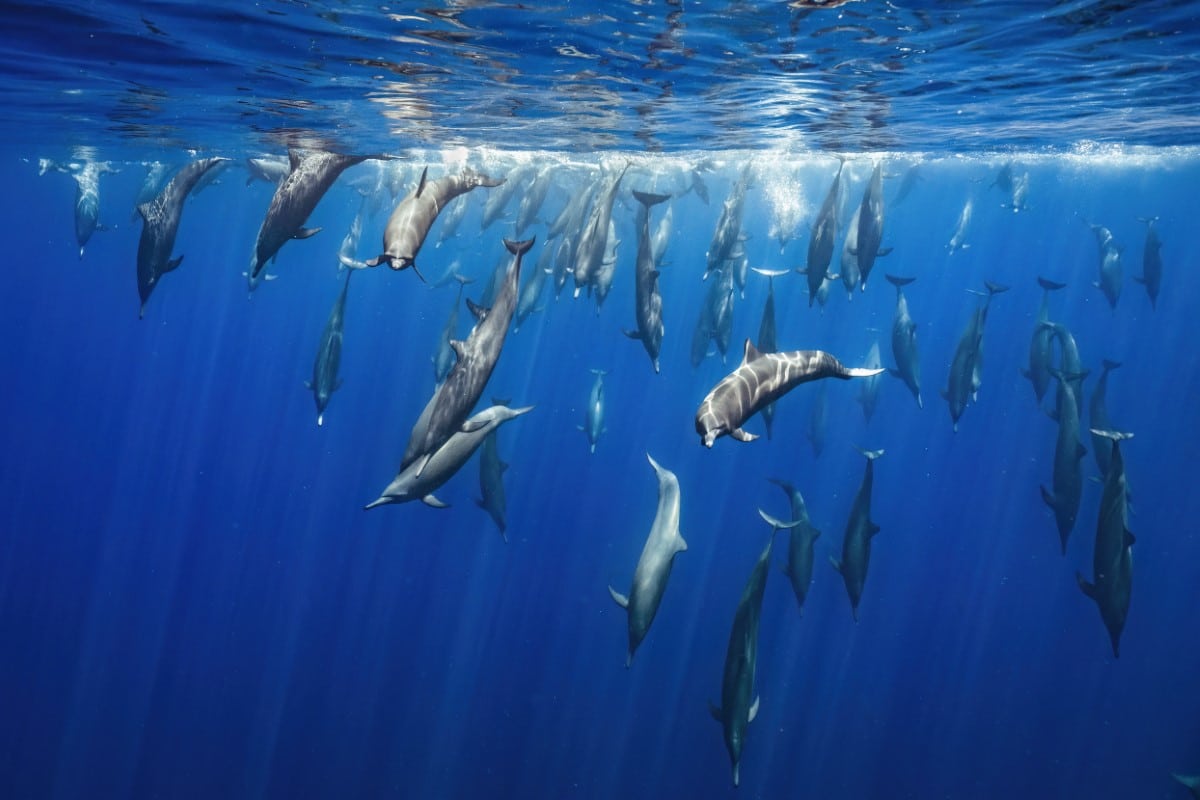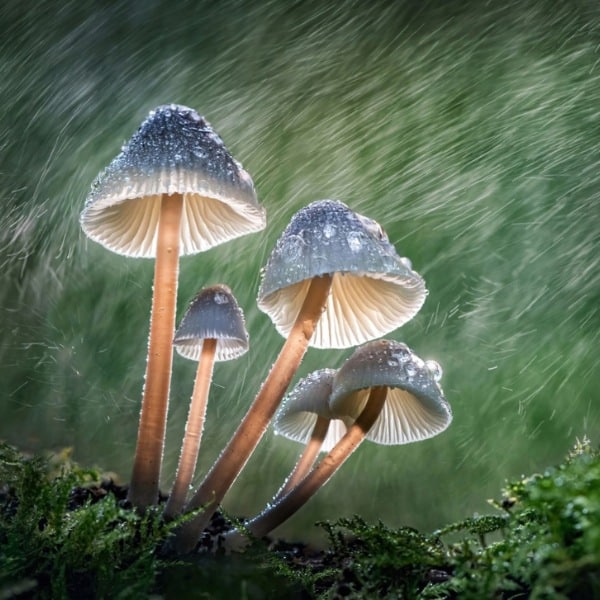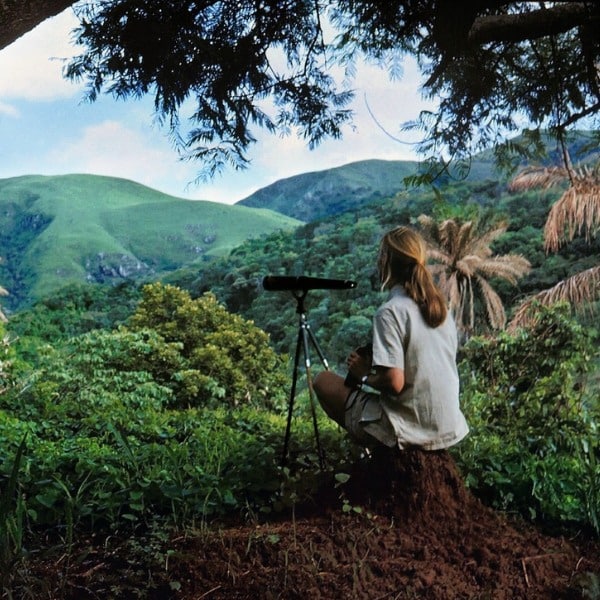
“The Things You Do for Love” by Amit Eshel. Winner, Wildscape & Animals in Their Habitat.
“Looks like the set for the next Mission Impossible, but for Nubian Ibexes, the high-altitude rocky terrains are home. The vulnerable ibex species is known for many things–large semi-circular horns, the ability to scale mountains with ease and the territorial fights that males engage in during the rutting season. Displays of dominance begin with showing off their impressive horns. If that doesn't do the trick, it's time to escalate by pushing and shoving the opponent and literally locking horns with them. Ibexes also stand on their hind legs as they get ready to strike.”
The 2023 Nature inFocus Photography Awards recently announced its winners during a ceremony held in Bangalore, India. The winners were selected from 24,000 images of wildlife submitted by over 1,500 photographers. In the end, filmmaker and conservationist Srikanth Mannepuri was named Photographer of the Year for a portfolio of images that highlight the threats facing mangrove forests along the coast of India.
Photographers from around the globe were invited to submit their best photography to six categories—Animal Portraits, Animal Behaviour, Conservation Focus, Creative Nature Photography, Wildscape & Animals in Their Habitat, and Photographer of the Year – Portfolio. While the contest's origins are in India, this year's competition saw increased participation from international photographers.
“The Nature inFocus Photography Awards has grown to become a meeting place for national and international photographers,” says Rohit Varma, one of the founders of Nature inFocus. “Every year, we see images that reveal new facets of our natural world while shining a light on pertinent global conservation issues. We are thrilled to see the growth in the number of participants and the geographical locations. It truly has become an international platform for wildlife photographers!”
From exciting moments of leopards stalking their prey to incredible compositions using insects, the creative visions of nature from this year's winners are exceptional. We've gathered some of our favorite winners from this year's contest below, and you can check out the full list on the Nature inFocus website.
The Nature inFocus Photography Awards highlights the power of wildlife.

“Shell I Eat You?” by Sankhesh Dedhia. Winner, Animal Behaviour.
“This stunning action shot captures a rarely-seen natural history moment, where the legendary Arrowhead of Ranthambhore fishes out an Indian Softshell Turtle from the lake for lunch. A tiger’s diet in the wild can be very varied as the felid can prey on pretty much everything on its turf, even a turtle, hence proved!”

“Disappearing Guardians” by Srikanth Mannepuri. Winner, Photographer of the Year – Portfolio.
“Entirely shot from a drone, the photographer zooms out on the mangrove forests of coastal Andhra Pradesh to capture the magnitude and scale of the threats this unique ecosystem is facing today.”

“Lights Will Guide You Home” by Merche Llobera. Special Mention, Animal Behaviour.
“A pod of Spinner Dolphins dives back into the beautifully lit waters of the Pacific Ocean, creating this stunning scene of a cetacean avalanche. One of the dolphins can be seen gazing into the camera lens, adding a touch of curiosity and connection to the frame.”

“A Love Like No Other” by Afroj Sheikh. Winner, Animal Behaviour.
“Caught in the crosshairs of a hungry leopard, the vulnerable mother and baby langur had little chance of survival. The hunt and the chase had led the predator and prey up a tree before the mother succumbed to the suffocating hold of the large cat. But in embracing death, the mother was able to save her offspring.”

“A Sappy Alliance” by Avinash PC. Winner, Animal Behaviour.
“Symbiotic relationships are plenty in the natural world! But none as sappy and sugary as the mutualistic relationship between ants and aphids. Aphids are tiny, sap-sucking insects that are serious plant pests. They secrete a sugar-rich liquid called honeydew, a favorite food of ants! So much so that the ants protect these insects from other predators and even shepherd them to the healthiest parts of the plant to maintain a steady stream of sweet honeydew!”

“Inspector Booby” by Suliman Alatiqi. Winner, Animal Portraits.
“Brown Boobys spend a significant portion of their lives in the open ocean. Their clumsy nature on land earned them their namesake, derived from the Spanish word bobo, which means stupid or daft. They are excellent foragers of the sea and plunge-dive to feed on anything from anchovies and sardines to squid and shrimp. The photographer watched this individual dipping its head underwater at short intervals and got in position to capture a close-up portrait of the bird from the perspective of its fated prey.”

“The Bonobo and His Pet” by Christian Ziegler. Winner, Animal Portraits.
“The last great ape to be described, the Bonobo, is one of our closest living relatives. Here, a wild Bonobo who caught a mongoose pup is looking after it like a pet. He later released the animal unharmed. This behavior has only been recorded once before by Prof Barbara Fruth at this site.”
The winners were selected from 24,000 images.

“Symmetry in Mimicry” by Arkaprava Ghosh. Winner, Creative Nature Photography.
“Mimicry is the highest form of flattery, they say. But in the animal world, it is among the best defense mechanisms. Here, Line-forest Skimmers position themselves aptly on the perennial Phanera vahlii creeper to resemble an inflorescence. Notice how the dragonflies have raised their abdomens in unison? Fooling a predator never looked this intricate.”

“Slender in the Night” by Arnav Deshpande. Winner, Young Photographer.
“Like the spiders they are commonly confused with, Harvestmen too have eight legs–mostly long and thin in contrast to their bodies. They are living fossils, the original ‘Daddy Longlegs,’ having remained unchanged for millions of years. On a rainy night, the young photographer spotted this Opilione sheltering in a crevice, raindrops glistening on its limbs.”

“Chiaroscuro” by Kai Kolodziej. Winner, Creative Nature Photography.
“Here is a gentle reminder that photographing the natural world is not just about documenting the megafauna but also zooming in on the speck on a blade of grass to reveal the chiaroscuro of a mayfly.”

“Gecko’s Garage” by Vidyun Hebbar. Special Mention, Young Photographer.
“The Andaman Day Gecko or the Green Emerald Gecko is a bright-colored gecko endemic to the Andaman islands. The young photographer was on vacation when he spotted this shy creature lurking inside a chandelier light.”

“The Rarest of Them All” by Sergey Gorshkov. Special Mention, Wildscape & Animals in Their Habitat.
“One of the rarest cats in the world, the Amur Leopard certainly makes you earn your sighting. The critically endangered felid faces several threats, including poaching for its fur. While suitable habitats are present across Russia and China, these leopards are threatened by the scarcity of prey animals.”

“Giants in Peril” by Lalith Ekanayake. Special Mention, Photographer of the Year – Portfolio.
“In Sri Lanka, Asian Elephants are considered sacred animals, associated with the Temple of the Sacred Tooth Relic in Kandy. Despite this cultural status, they face challenges such as human-elephant conflict and habitat loss. Villagers often suffer crop destruction, yet maintain respect for these majestic creatures.
Once found throughout the island, the elephants’ ancient homes and migratory routes are now restricted. They are classified as Endangered by the IUCN, highlighting the need for immediate conservation efforts.”

“Skimmer Love” by Padmanava Santra. Special Mention, Creative Nature Photography.
“The atmospheric blue brushstrokes, the warm sunset glow on the orange bills of the Indian Skimmers and the bokeh on the water body; what’s not to love about this image?”

“Easy Like a Sunday” by Bharath Kumar V. Special Mention, Animal Portraits.
“Live life king-size, they say. So if you are the king of the jungle, what do you do after a hearty meal but roll over and relax? Never mind the flies all around, trying to break your siesta.”

“Cry Me a River” by Hiren Pagi. Winner, Conservation Focus.
“Every once in a while, news sites report that a dead crocodile was found in the Vishwamitri river, a fleeting acknowledgment of the water body’s ~270 Mugger Crocodiles. The image shows the conditions in which these reptiles coexist with humans. The river has become a dumping yard for the nearby establishments, and in various places, drainage water also makes its way into the mix. The Mugger Crocodiles of the river face many threats, including habitat loss and water pollution.”

“Raiders of Hives” by Pranav Mahendru. Winner, Young Photographer.
“In the dense forests of Satpura, a pair of Oriental Honey Buzzards raid a beehive. These raptors hunt for food in beehives and wasp nests but, unlike what their name suggests, they prefer bee and wasp larvae over actual honey.”

“Worlds Apart” by Dileep SS. Winner, Wildscape & Animals in Their Habitat.
“Think Dubai and the first thing that comes to mind is architectural marvels that make the sky seem at arm's reach. The tall buildings may be Dubai's trademark visuals, but another world coexists alongside the dazzle, where wildlife thrives in the desert. The image juxtaposes these two worlds—the towering skyscrapers and the endless sands—a gentle reminder to look beyond the concrete.”






















































































